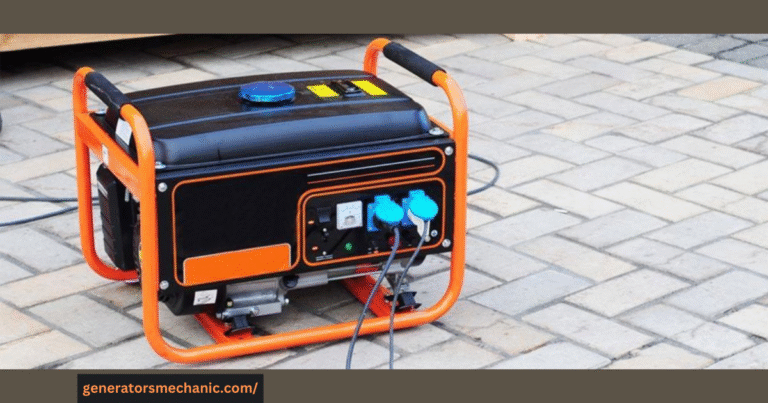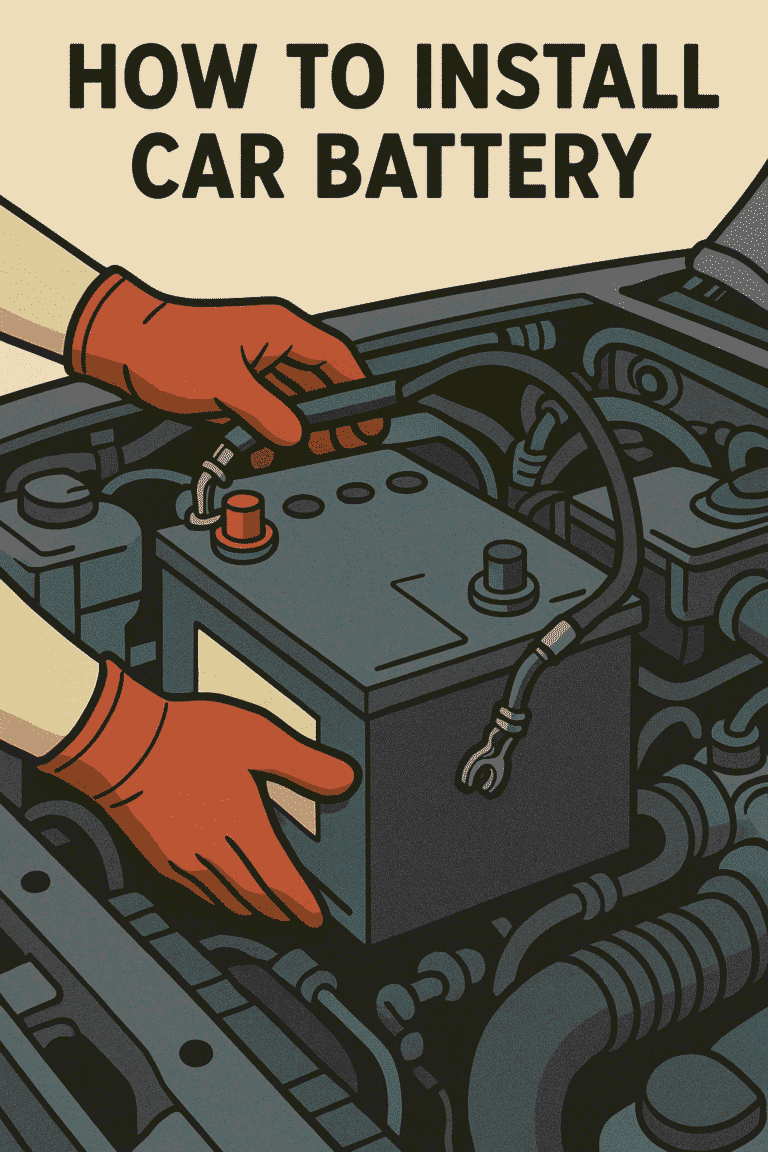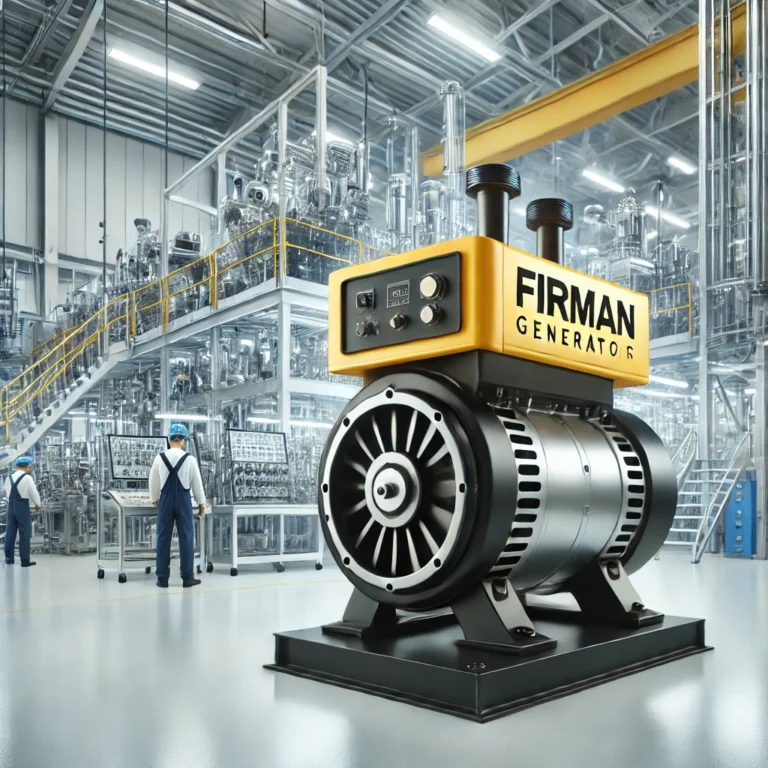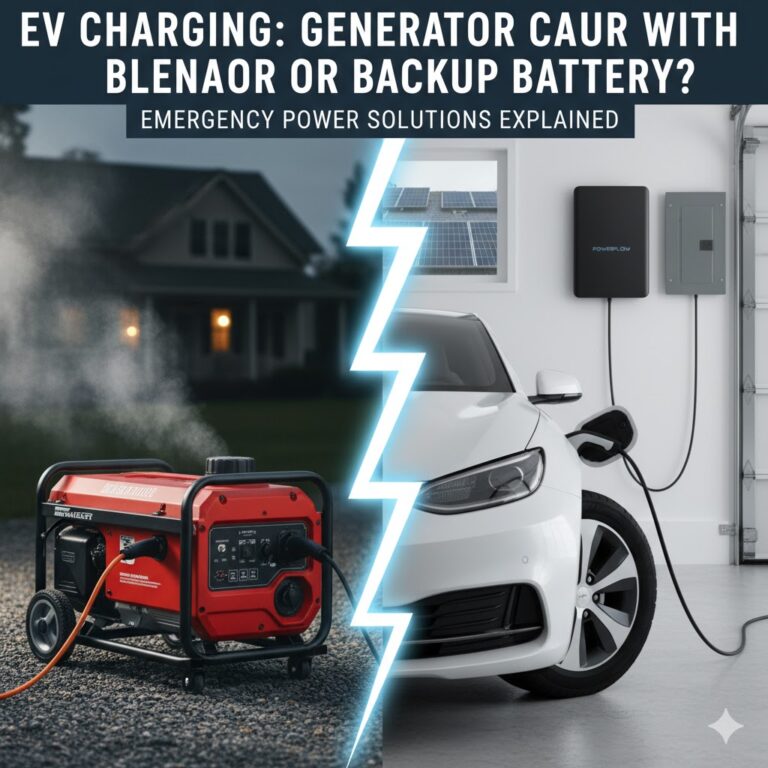What Are VRLA Batteries – 7 Powerful Facts You Must Know About This Reliable Power Source

Alright, let’s dive headfirst into the world of VRLA batteries.
These aren’t your typical bunny-powered cells; we’re talking about the heavy lifters of the battery world.
VRLA, short for Valve Regulated Lead Acid, is a type of lead-acid battery that is fully sealed and requires no maintenance.VRLA stands for Valve Regulated Lead Acid, and these batteries mean serious business. They’re the kind you’d trust to keep your gear running without fussing over them every five minutes.
- Picture a battery that doesn’t need a water top-up or worry about spilling acid everywhere. That’s your VRLA battery for youa true workhorse in a suit.
Now, there are two main stars in the VRLA lineup: AGM and gel batteries. AGM batteries, or Absorbent Glass Mat for those who like specifics, are tough cookies.
They can handle a shake and a tumble without batting an eyelid, perfect for when life gets bumpy. Then you’ve got gel batteries, which are the cool characters that stay chill under pressure, thanks to their gel-filled insides. Both types aren’t fans of overcharging, but treat them right, a
nd they’ll be the most reliable power pals you could ask for.
What makes these batteries special isn’t just their sturdiness or maintenance-free lifestyle; it’s their flexibility. You can flip them, turn them, or mount them sideways, and they won’t complain.
From powering your weekend escapades in an RV to keeping critical systems running smoothly, these batteries are all about delivering the juice exactly where it’s needed, no drama.
Just remember, while they’re tougher than your average lead-acid battery, showing them some love with proper charging and care goes a long way in keeping the lights on.
Understanding VRLA Technologies
Valve-Regulated Lead-Acid (VRLA) batteries are sealed, maintenance-free batteries designed to provide reliable power in applications like UPS systems, solar storage, and even generators. Unlike traditional flooded batteries, VRLA models don’t require regular topping off with water and are much safer in indoor or enclosed environments.
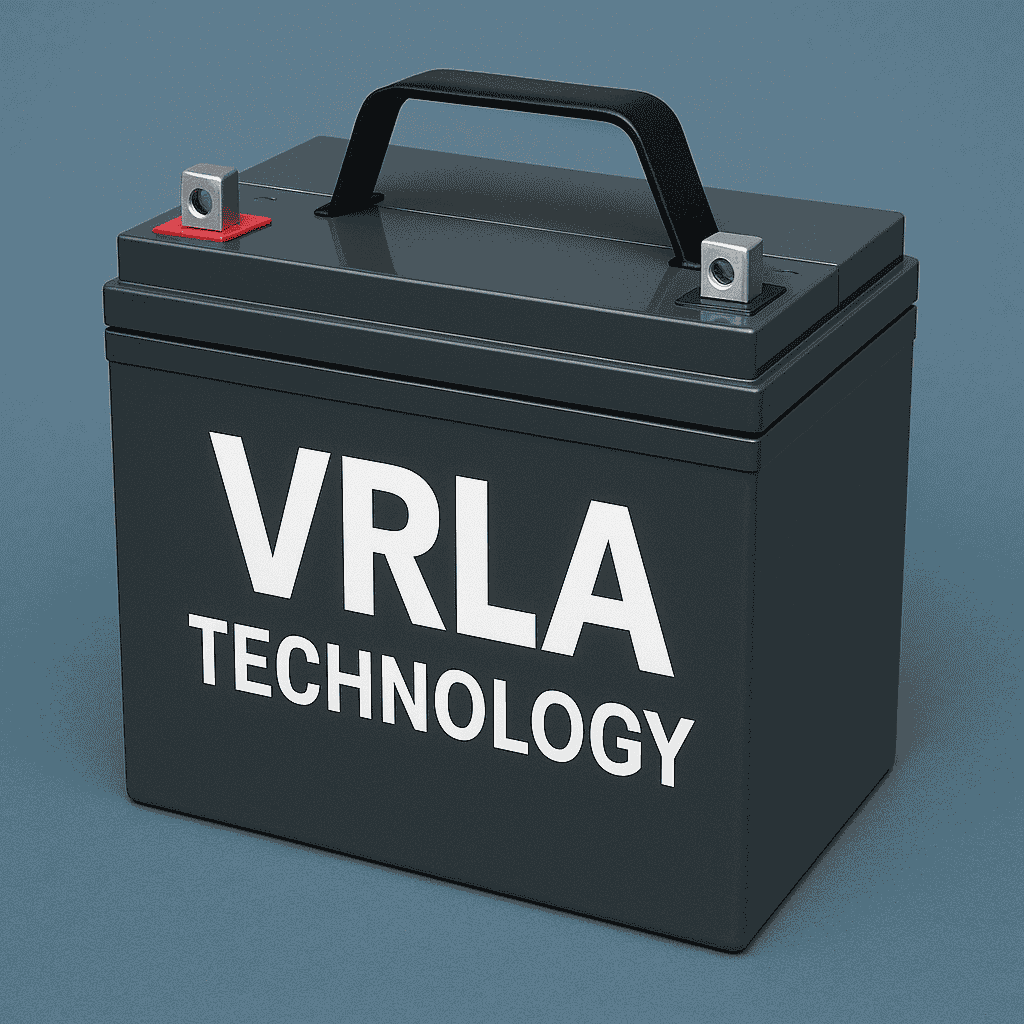
When it comes to comparing VRLA battery vs AGM, it’s worth noting that AGM (Absorbent Glass Mat) is actually a type of VRLA battery. The other common type is Gel. While both are sealed and maintenance-free, AGM batteries tend to offer better performance for high-drain applications, whereas Gel batteries are more suited to deep cycle usage. Understanding these differences can help you choose the right battery type for your specific energy needs.
Digging a bit deeper, VRLA technology is pretty nifty. At its heart, it’s all about keeping things sealed tighter than a jar of pickles. This design choice doesn’t just minimize mess and maintenance; it’s a safety feature, keeping hydrogen gas and acid securely inside.
Think of it like a soda bottle – if you shake it up, it won’t burst until you pop the top. VRLA batteries work under a similar principle, but instead of soda, they’re filled with electrical goodness ready to be tapped when you need it.
The Basics of VRLA Batteries
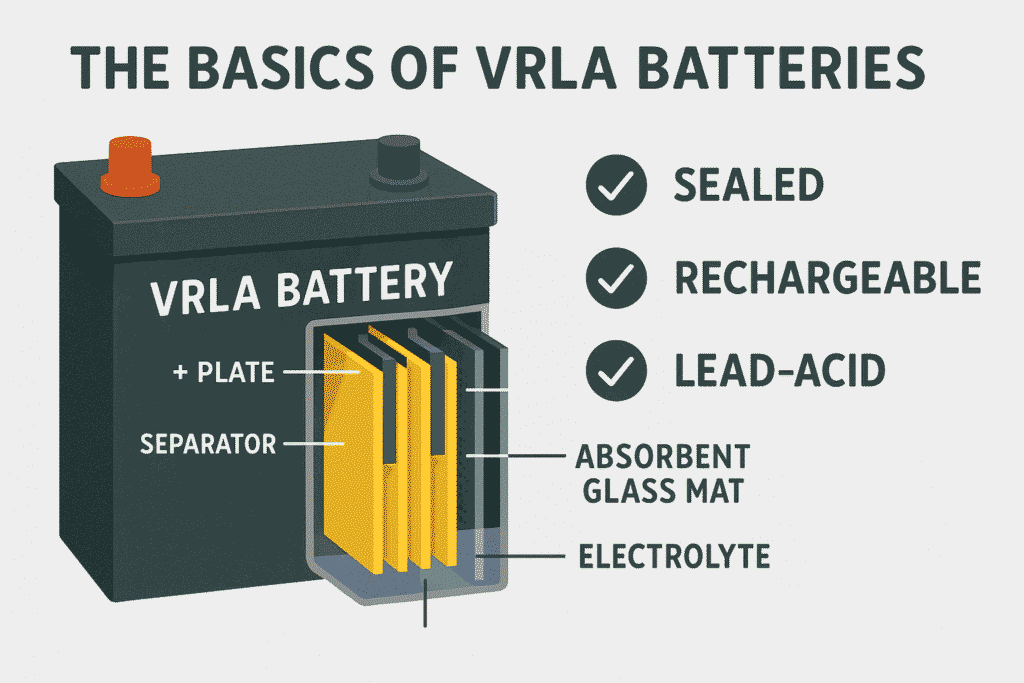
At their core, VRLA batteries are like the strong, silent type. They don’t make a fuss with gassing or require constant check-ups like their flooded lead-acid cousins. Thanks to their valve-regulated design, they keep everything inside without much upkeep. Plus, they pack a punch in a smaller, more manageable package.
This means you get a reliable source of power without sacrificing valuable space or dealing with high-maintenance drama. They’re the sturdy, dependable type everyone wants on their team.
Valve Regulated Lead-Acid Structure
Getting into the nuts and bolts, VRLA batteries are a masterclass in maintenance-free living.
Each battery sports a clever valve that keeps things running smoothly, allowing just enough gas to escape to prevent any pressure buildup. This means you’re not spending your weekends topping up water levels or fretting over acid spills.
It’s all sealed up tight, ready to roll whenever you are. Whether you’re setting it upright or flipping it on its side, these batteries adapt to your setup, not the other way around.
But it’s not just about convenience; it’s about reliability. The sealed battery design makes VRLA units a safe bet for sensitive environments where leaks or spills could spell disaster.
Plus, there’s no constant maintenance to worry about. Once they’re installed, you can practically forget they’re there, focusing on the task at hand rather than babysitting your battery. It’s freedom in a box – power when and where you need it, no strings attached.
Evolution and History of VRLA Batteries
Tracing the roots of VRLA batteries, it’s a journey from humble beginnings to high-tech solutions. Initially, the lead-acid battery was all about brute force – hefty, high-maintenance, and a bit clumsy.
Enter VRLA technology, flipping the script by offering a no-fuss, sealed design that changed the game. It was like switching from a gas-guzzling clunker to a sleek, efficient hybrid. The industry took notice, and soon these maintenance-free marvels were powering everything from emergency lights to off-grid adventures.
From Early Lead-Acid to Modern VRLA
The transformation from early lead-acid to modern VRLA batteries is a tale of innovation and improvement. Picture a world where battery maintenance is a weekend routine, involving gloves, goggles, and a whole lot of patience.
Then VRLA batteries roll up, with their sleek sealed designs and a promise of a maintenance-free life. It was a revolution on par with the move from flip phones to smartphones – a quantum leap in convenience and reliability.
This isn’t just a minor upgrade; it’s a whole new way of powering our lives, cleaner, safer, and way more convenient.
Moreover, these advancements weren’t just about making life easier for the end-user.
They were about safety, efficiency, and adapting to a world where mobility and reliability are king. VRLA batteries stepped up, offering solutions that could withstand shock and vibration, and deal with the demands of modern life.
From powering emergency systems to taking renewable energy storage to the next level, these batteries have become the backbone of a myriad of applications, pushing the envelope of what’s possible with portable power.
Types of VRLA Batteries
Valve-Regulated Lead-Acid (VRLA) batteries are a type of sealed lead-acid battery designed to offer maintenance-free operation and enhanced safety. Unlike traditional flooded lead-acid batteries, VRLA batteries are sealed, which prevents leakage and allows them to operate in various orientations — a key advantage for applications like UPS systems, solar setups, and telecom equipment.
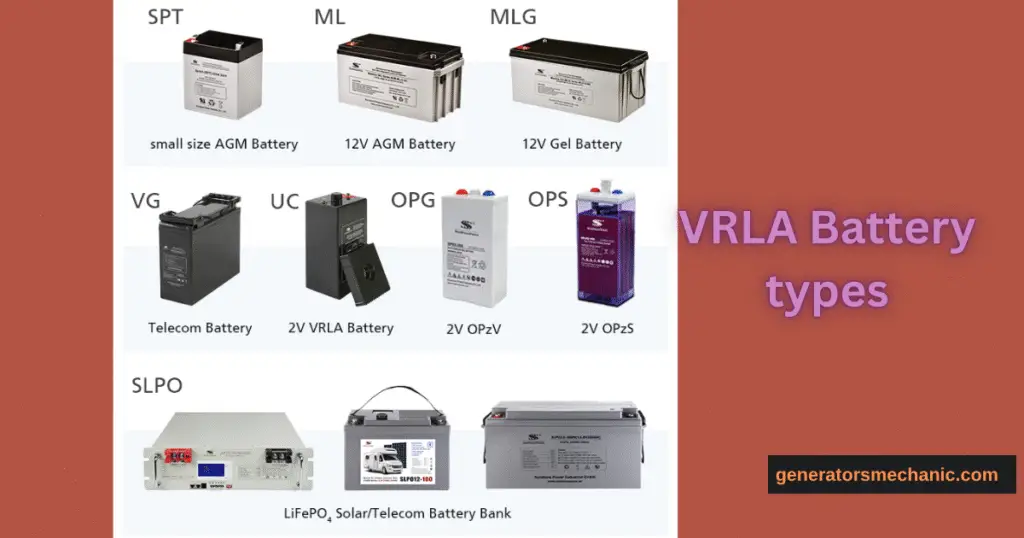
There are two main types: Absorbent Glass Mat (AGM) and Gel Cell. AGM batteries use a glass mat separator to hold the electrolyte in place, offering better power output and lower internal resistance. Gel batteries, on the other hand, use a silica-based gel to suspend the electrolyte, making them more vibration-resistant and ideal for deep-cycle use. — VRLA batteries offer a more modern and user-friendly solution.
Within the realm of VRLA batteries, there’s a duo that stands out: AGM and gel. Each brings its own spice to the table. AGM batteries, with their absorbent glass mats, are like the marathon runners – efficient, sturdy, and ready for a long haul.
On the flip side, gel batteries add a bit of zen to the equation, with silica dust turning the electrolyte into a thick, calm sea that cushions the battery’s internal workings.
This gel setup is the battery equivalent of a smooth ride in luxury, offering stability and peace of mind, whether you’re keeping vital medical equipment running or storing solar power for a rainy day.
Absorbent Glass Mat (AGM) Batteries
Now, AGM batteries, they’re something special. Imagine the engine inside a tank – robust, reliable, ready for anything. That’s your AGM battery.
This type uses a fiberglass mesh sandwiched between the battery plates, soaking up the electrolyte like a sponge. It’s a design born from the need for power that doesn’t blink at bumps or jostles, making these batteries perfect partners for rough-and-tumble applications.
Advantages and Unique Features
Here’s the scoop on why AGM batteries are a bit of a big deal. First off, they’re tough. Not just physically, but in their ability to keep charging and powering through situations where other batteries might throw in the towel. In terms of lead-acid cells, AGMs are the ones doing heavy lifting with a smile. Because their acid is all wrapped up in a fiberglass hug, these batteries can take a beating from shock and vibration without missing a beat.
Plus, their efficiency isn’t just about power delivery; it’s also about how they handle being emptied and refilled with juice. Quick to recharge and slow to complain, AGM batteries are like the dependable friend who’s always ready to lend a hand.
Besides their rugged charm, AGM batteries have a bit of a green streak. They’re more environmentally friendly, thanks to their sealed design that keeps all the nasty bits locked away. No leaks, no spills, just clean, reliable power.
And because they don’t gas like a wet-cell battery on a hot day, they’re safer for indoor use, making them a go-to choice for powering everything from home solar systems to the heart of an RV.
When you tally up the benefits – durability, safety, and efficiency – AGM batteries stand out as the power source of choice for those who want to keep their adventures running smoothly, without any hiccups along the way.
Gel Cell Batteries
Gel Cell Batteries stick out like a sore thumb in the world of batteries, and for some pretty cool reasons. Picture this: they’ve got an electrolyte that’s more like a jelly than a liquid, thanks to the magic of mixing sulfuric acid with silica.
What does that mean for you and me? Well, you can flip them, spin them, or mount them any which way, and they won’t spill a drop. Especially handy if you’re not keen on cleaning up battery acid.
Plus, they’re tough cookies, giving the cold shoulder to extreme temperatures and shrugging off knocks and vibrations like it’s nothing. Mostly, you’ll find these rugged powerhouses in electric wheelchairs, some recreational vehicles, and generators, powering through tasks where other batteries might throw in the towel.
Key Differences From AGM and Applications
Now, when it comes to AGM batteries and Gel Cell Batteries, it’s like comparing apples and oranges – both fruit, but quite different. AGM batteries soak up the acid like a sponge with their absorbent glass mats, which seals the deal for them being spill-proof and pretty low maintenance.
Gel Cells, on the other hand, take the game to the next level with their gel-form electrolyte. This gel setup is a champ at dealing with deep discharges and bounces back better than AGM for repeated heavy use. Ideal for wheelchairs and RVs where reliability is key.
But here’s where it gets spicy: AGM batteries charge faster and can handle a bit more rough and tumble with charging rates. Yet, Gel Cells are the marathon runners, preferring a slow and steady charge to last longer.
This difference makes each suitable for its stage, AGM sprinting ahead in high-powered, quick-use scenarios, and Gel Cells taking the crown for endurance and steady, long-term performance.
Detailed Comparison
Simply put, they are sealed lead-acid batteries designed to be maintenance-free and highly efficient for various applications like backup power, UPS systems, and solar setups. Unlike traditional flooded batteries, VRLA batteries are spill-proof and can operate in any position, which makes them ideal for both residential and commercial use.
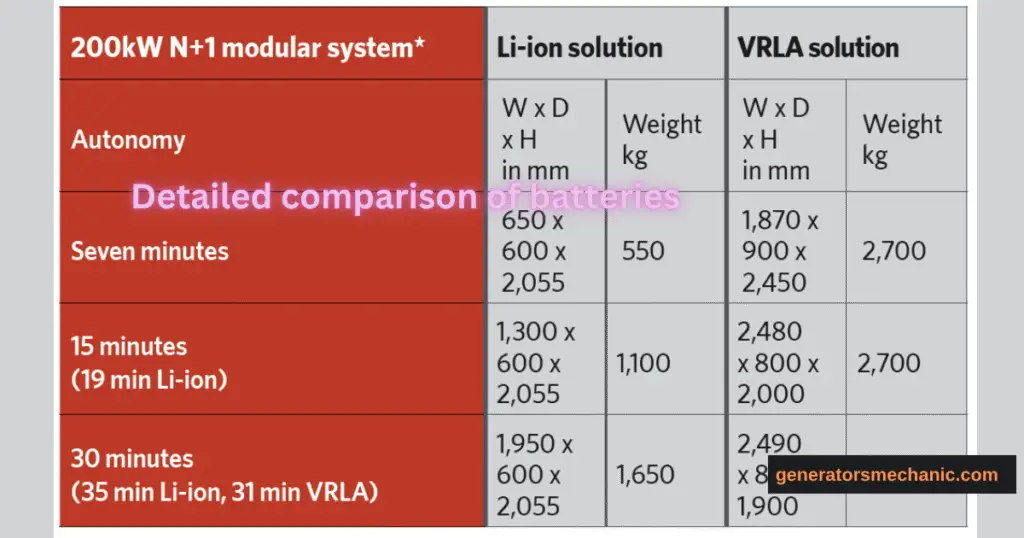
The VRLA battery full form is “Valve Regulated Lead Acid,” referring to the one-way valve system that regulates internal gas pressure while preventing leakage. In comparison to other battery types, VRLA batteries stand out for their safety, longevity, and minimal upkeep—making them a solid choice for users who need reliable and stable energy storage without constant maintenance.
Dipping our toes into the sea of batteries, AGM and Gel Cell batteries float up as top contenders in the VRLA category. Both have their fan clubs, rooted in their unique benefits and quirks.
AGM batteries, with their faster charging arms race and robust performance, sit well with those needing quick power-ups. Gel Cells, riding the waves at a more measured pace, appeal to those valuing longevity and resilience, specifically in face of deep discharges.
It’s a battery battle royale, where the crown is decided by the specific demands of the kingdom they’re to serve.
AGM vs Gel: Which One Should You Choose?
Choosing between AGM and Gel batteries is like picking your favorite superhero. Each has their powers and weaknesses.
AGM batteries jump into action faster with quicker recharge times and are tough as nails, making them the go-to for high-demand applications. Gel batteries, donning their capes of durability, outlast and outperform in the marathon of deep, cyclic uses. Your choice? It boils down to what kind of hero you need: the sprinter or the long-distance runner.
Performance in Extreme Conditions
Let’s not beat around the bush: when mother nature throws a tantrum, you want your battery to stand its ground. AGM batteries snugly fit into the roles of the reliable warriors, powering through cold snaps and simmering heat without breaking a sweat.
Their built tough reputation isn’t just for show, making them a street-smart choice for outdoor and heavy-use applications.
Gel Cell Batteries step into the ring with an ace up their sleeve for temperature tolerance. They’re like the chill mountain monks of batteries, unfazed by the ups and downs of temperature extremes.
If your gear will face the wrath of Mother Nature’s mood swings, Gel might just be the zen master you need to keep the lights on.
VRLA Batteries vs Flooded Lead-Acid Cells
In the slugfest of battery types, VRLA batteries, including both AGM and Gel Cells, dance around the traditional flooded lead-acid cells like Muhammad Ali.
They’re lean, mean, fighting machines that pack a punch with less maintenance and no watering necessary.
While flooded cells might take a licking with their higher energy density and initial cost savings, VRLAs keep ticking, offering spill-proof designs and safer handling. It’s about choosing your fighter wisely based on your battleground demands.
Maintenance and Lifespan Considerations
Lead-acid batteries, from the rugged AGM to the stoic Gel Cells, and even the traditional flooded, are like pets. Some need more walking and grooming, while others are happy with just a cozy corner to nap.
Traditional flooded batteries are the high-maintenance pets of this analogy, requiring regular check-ups, water top-ups, and careful handling to avoid spills and acid mishaps.
The VRLA family, on the other hand, are more like your low-maintenance, chill reptiles or cat, content with minimal fuss – a bit of monitoring to ensure they’re not overcharged, and they’re good to go.
Yet, all pets grow old, and so do batteries. The lifespan game sees AGM and Gel Cells often outlasting traditional flooded batteries, especially in tough conditions or demanding applications. However, like choosing between a tortoise and a hamster, your pick depends on your commitment level and what you need from your battery life.
Longevity or cost-effectiveness? The choice shapes your battery’s maintenance and lifespan journey.
Practical Applications of VRLA Batteries
Valve-Regulated Lead-Acid (VRLA) batteries are sealed, maintenance-free power sources widely used in both residential and industrial settings. Their practical applications range from backup systems in uninterruptible power supplies (UPS) to powering telecommunications equipment, emergency lighting, and even renewable energy setups. Thanks to their sealed design, they can be safely installed in enclosed or sensitive environments without the risk of acid leaks or frequent upkeep.

When comparing VRLA battery vs lithium-ion, VRLA batteries are often preferred for their cost-effectiveness and reliability in standby applications, while lithium-ion stands out for longer lifespans and faster charging. Each has its place, but VRLA batteries continue to be a trusted choice where safety, stability, and affordability are top priorities.
Diving into the world of batteries, let’s get real: VRLA batteries, be it the hustling AGM or the enduring Gel Cells, are workhorses across the board.
They’re like the unsung heroes behind the scenes, ensuring the show goes on, from the energy needed in backup systems and emergency lighting to the power driving golf carts and electric wheelchairs. Their ability to recharge faster than their flooded lead-acid cousins, coupled with their no-fuss, spill-proof nature, makes them a solid choice for a plethora of applications.
To boot, they’re pretty much maintenance-free, which is music to the ears of anyone who’d rather not babysit their batteries.
Renewable Energy Systems and Storage
When it comes to catching and storing those golden sun rays or the whimsical winds, VRLA batteries step up to the plate. Their stalwart nature makes them ideal candidates for renewable energy systems, where reliability and endurance are the names of the game.
Whether it’s storing power from solar panels or keeping the lights on when the wind turbines are taking a breather, these batteries are ready to roll with the punches, ensuring that renewable energy is there when you need it, day or night.
Wind and Solar Energy Storage Solutions
Imagine this: the wind’s blowing, the sun’s shining, and your VRLA batteries are soaking it all up like a sponge. These power-storing virtuosos slide seamlessly into wind and solar energy systems, offering a buffer that keeps the green energy flowing even when conditions aren’t picture-perfect. Their claim to fame?
An impeccable ability to stand guard over your renewable resources, ensuring that even when the elements are asleep, your energy supply is wide awake.
The beauty of VRLA batteries in this green energy saga is their adaptability. They can hang tight with the best of solar inverters and dance with the most capricious wind turbines, making renewable energy systems not just a daydream but a day-and-night reality.
It’s about keeping the lights on, the water warm, and the air crisp with as little fuss as possible, and VRLA batteries lead the charge in this eco-friendly crusade.
Electric Vehicles and Personal Transport
Rolling onto the scene, VRLA batteries are taking the electric vehicle and personal transport worlds by storm. No longer just the trusty sidekicks in golf carts or mobility aids, they’re powering a revolution on two wheels and four.
The reasons? They’re lightweight, they pack a punch, and they’re in it for the long haul, making them perfect for the green tech of personal transport.
From electric bicycles zipping through city streets to scooters cruising the boardwalk, these batteries are the silent warriors making clean, green transport a reality for more and more folks.
Advantages of VRLA in Electric Bicycles
If you’ve ever considered ditching the gas guzzler for something greener, like an electric bicycle, then VRLA batteries are your new best friends.
These little powerhouses pack a punch, giving your ride the juice it needs without the weight dragging you down. And let’s not forget, they’re low maintenance; you won’t be spending your weekends tinkering in the garage just to get to work on Monday.
It’s not just about less sweat on the maintenance though; these batteries also hold their charge like a champ. Imagine pedaling up a hill, and instead of your bike coughing and spluttering, it zips up as if it’s got a turbocharger.
That’s the VRLA advantage – consistent power that makes those uphill climbs feel like a breeze, making it a no-brainer for electric bikes.
Safety and Maintenance Insights
These are Valve-Regulated Lead-Acid batteries, a sealed type of lead-acid battery designed for low maintenance and enhanced safety. Unlike traditional flooded batteries, VRLA batteries don’t require regular watering and are spill-proof, making them ideal for backup power systems and enclosed spaces.
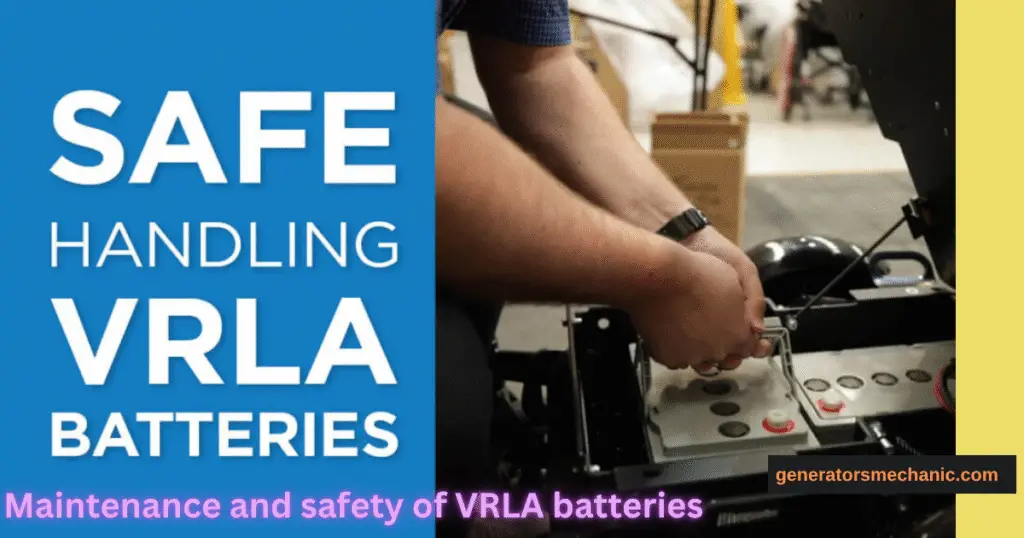
When it comes to safety and upkeep, it’s crucial to understand both VRLA battery advantages disadvantages — they offer reliable performance, low emissions, and easy installation, but their lifespan can be limited if not properly charged or stored. Regular checks for terminal corrosion, proper ventilation, and monitoring voltage levels can significantly extend their life and maintain safe operation.
Now, I get it, when it comes to batteries, especially the types that promise less fuss, it’s easy to slide into the “set and forget” mindset.
But here’s the thing with VRLA batteries – they may need less babysitting compared to their traditional flooded lead-acid batteries cousins, but a little TLC goes a long way.
Taking a moment to keep them clean and checking on their charge can save you from future headaches. No advanced degree required, just a bit of common sense and a splash of elbow grease.
Charging and Handling VRLA Batteries Safely
Handling any battery calls for a bit of know-how, especially VRLA batteries. These aren’t your average batteries. They’re designed to be user-friendly, sure, packing less of a hydrogen gas punch on the release and boasting a quicker recharge time than their flooded lead-acid batteries counterparts. But don’t get it twisted; treating these batteries right involves respecting their limits.
Overcharge them and they’ll throw a fit by cutting their life short. No one wants that, so paying attention and not treating them like they’re invincible is key.
Avoiding Thermal Runaway and Extending Battery Life
Everybody wants their tech to last longer, and it’s no different with VRLA batteries. One key enemy to battery life? Heat. Think of thermal runaway as a battery’s meltdown – literally.
Keeping these batteries cool and collected means they’ll live to see another day, many days, actually. Monitoring the ambient temperature isn’t just fancy talk; it’s about giving your battery a comfy spot that won’t cook it from the inside out.
And here’s a kicker – it’s not just about dodging the heat. Regular check-ups on your battery can prevent that dreaded walk of shame when your bike decides it’s nap time mid-journey.
A VRLA battery treated right, with a keen eye on not pushing it to extremes, can reward you by outliving its predictions, making every penny spent on it seem like money well spent.
Vital Maintenance Tips for Optimal Performance
Let’s face it, nobody buys a battery dreaming about the endless maintenance. That’s the beauty of VRLA batteries; they’re pretty much the low-maintenance sweetheart of the battery world.
But – and it’s a small but – don’t think it’s a fire-and-forget situation. A quick dance around with a cloth and some industrial cleaner to keep the connectors and terminals singing, free from the grime and corrosion, and you’re setting yourself up for a smooth ride.
Throw in periodic checks for charge and overall health, and you’re golden.
Routine Checks and Environmental Considerations
Picture this: it’s a beautiful morning, and you’re ready to hit the road. But your ride, well, it’s not. Could’ve been avoided with some routine love and care.
Checking in on your VRLA battery doesn’t need to be a chore – it’s like giving your bike a quick once-over to make sure it’s up for the adventure. Look at the terminals, check if the charge is holding up, and you’re halfway there.
Environment’s the other half of this tale. Those batteries like it cool and dry, not too different from how most of us feel about a comfortable living space.
Park that bike in a sweltering garage, and you’re asking for trouble. Keeping it in a spot that doesn’t swing from sauna to freezer every other day keeps that battery ticking over, ready for whatever road lies ahead.
Future and Innovations
These are Valve-Regulated Lead-Acid batteries, known for being sealed, maintenance-free, and highly efficient energy storage solutions. With the increasing demand for dependable backup power and renewable energy systems, VRLA batteries are evolving rapidly to meet modern energy needs.
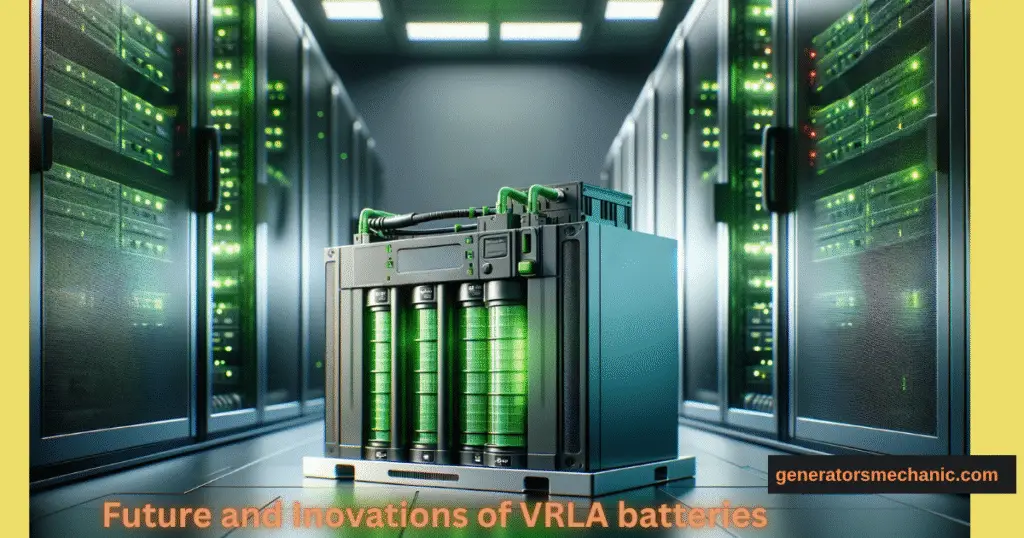
As technology advances, these batteries are being made more compact, longer-lasting, and eco-friendly. In terms of application, what are VRLA batteries used for today extends far beyond traditional backup systems—they’re now widely used in solar setups, UPS systems, telecommunications, and even electric vehicles. The future of VRLA technology looks promising, with ongoing innovations focusing on extending battery life, reducing charging time, and improving energy density.
The road ahead for VRLA batteries looks like it’s lined with more than a few good turns. With every passing year, these power packs are getting smarter, greener, and more reliable. Innovation isn’t just a buzzword here; it’s the engine driving VRLA into the future, based on solid tech and a dash of ingenuity. Watch this space.
The Next Generation of VRLA Batteries
Tomorrow’s VRLA batteries aren’t just sitting tight; they’re on the move, innovating, becoming more efficient, and packing a punch in power without upping the weight. It’s evolution in the battery world, with each iteration sharper than the last, promising to keep our tech and rides juiced up longer without handing us a hefty maintenance manual. Exciting times ahead, folks.
Internal Catalysts and Oxygen Cycle Enhancement
Here’s where things get a bit sci-fi with VRLA batteries – we’re talking about internal catalysts working their magic, making the whole operation smoother.
These upgrades aren’t just for show; they’re about efficiency, about making the battery’s life longer by improving how it manages the conversion of lead sulfate back into usable energy. Clever, right?
And then there’s the oxygen cycle – sounds fancy, but it’s all about keeping things inside the battery working just right, making sure it recharges like a dream without losing its cool. It’s like giving your battery a brain, one that knows how to keep itself in tip-top shape for the long haul. Now, that’s smart.
Comparison with Lithium Batteries
In the heavyweight battle of battery tech, VRLA holds its ground against lithium batteries. Sure, lithium talks a big game with its high energy density and featherweight status, but VRLA isn’t going down without a fight.
It counters with reliability, cost-effectiveness, and a robustness that lithium batteries often envy. Different strokes for different folks.
VRLA vs Lithium: The Future of Battery Technology
So, which battery tech wins the future? VRLA or lithium? It’s like asking whether chocolate or vanilla is better – it depends on your taste. VRLA batteries, with their rugged reliability and cost-effectiveness, make a strong case for those looking for a no-nonsense power source.
They’re the workhorses, ready to deliver without demanding too much in return.
But don’t count lithium out; it’s the sleek sports car to VRLA’s reliable sedan. High energy, low weight, and quick to recharge. In the end, the road forward might not be about choosing one over the other, but how both can drive us towards a future where energy is cleaner, greener, and smarter. That’s a race worth watching.
Making the Right Choice
Selecting the Suitable VRLA Battery for Your Needs
Alright, let’s dive into the world of VRLA batteries. If you’re looking to power up your uninterruptible power supplies, you’ve got to get familiar with these sealed lead acid wonders.
Why? Because they’re the backbone of a reliable backup power system. And guess what? You’ve got options. But, choosing the right SLA battery requires a bit of know-how. You see, these batteries are like the secret sauce in your grandma’s recipe – not all are created equal.
They come with their own mix of features, like how the electrolyte is held tight in those glass mats, eliminating spills and leaks. Makes sense, right? So, when picking the right VRLA for your needs, consider its role in your setup, its compatibility with your power requirements, and, of course, its maintenance and lifespan because you don’t want to be replacing these babies too often.
Factors to Consider and Final Recommendations
Now, when we’re talking about factors to consider, it’s not just about the sticker price. Think about thermal runaway – that’s a fancy term for a battery turning into a mini-volcano.
You don’t want that, so a VRLA that handles heat well is a keeper. Also, consider the power density and internal resistance. Why? Because you want a battery that packs a punch without wearing itself out too fast.
And don’t forget the deep cycle capabilities if you’re powering something that needs a constant, reliable source of juice.
Here’s my final swing at it: If your setup is crying out for a battery that’s tough, low-maintenance, and can handle a bit of a temperature tantrum, go for an AGM VRLA.
They’re like the reliable old truck that keeps running no matter what. But if your setup is more like a delicate, high-tech setup that needs a gentle touch, a Gel battery might be more your speed. They’re like that high-maintenance sports car – a bit more fussy, but with the right care, they perform beautifully.
Harnessing VRLA Batteries for Specific Sectors
Now, let’s talk about putting these VRLA batteries to work. These powerhouses aren’t just sitting pretty on a shelf; they’re out in the field, flexing their muscles in all sorts of applications.
From keeping the lights on in telecommunications to ensuring utility services are uninterrupted, VRLA batteries are the unsung heroes. They’re the backbone of reliability in sectors where a power hiccup can mean big headaches.
And the beauty of it? You’ve got AGM and Gel types that offer flexibility depending on your needs – be it quick recharge times, minimal gas discharge, or the ability to work in any orientation. But, like with anything worth having, it’s about picking the right tool for the job.
Telecommunications and Utility Sectors
In the world of telecommunications and utilities, VRLA batteries are like the night watchmen. Silent, vigilant, and always ready.
They keep things rolling smoothly, ensuring that when you pick up the phone or flick a switch, you’re connected. It’s about reliability and making sure that, come rain or shine, the power flows uninterrupted. In these sectors, a battery’s not just a battery; it’s a lifeline.
Customizable Solutions and Case Studies
But here’s where it gets interesting. Thanks to the versatility of VRLA batteries, companies can tweak and tailor their power solutions to fit just about any scenario. Think of it as bespoke tailoring but for your power needs.
From the dense urban jungle to remote outposts, these batteries are adaptable. There are stories out there, case studies, of places you’d never think would need such a high-tech solution, relying on AGM or Gel batteries to keep the lights on and the data flowing.
And it’s not just about keeping things running; it’s about doing it efficiently and sustainably. With innovations in VRLA technology, these case studies highlight how sectors are overcoming challenges like space constraints, extreme weather, and the demand for greener solutions.
It’s a testament to the humble VRLA battery’s role in not just powering the present but also shaping the future of energy use across industries.
Solar and Energy Storage Systems
Now, if there’s a match made in heaven, it’s VRLA batteries and solar power systems. This duo is like peanut butter and jelly – good on their own but unbeatable together. Why?
Because solar energy is all about capturing the sun’s bounty, but what do you do when the sun clocks out for the day? You store that golden sunlight in VRLA batteries, ready to power your world come nightfall or cloudy days.
Maximizing Efficiency in Renewable Energy
Here’s the scoop: solar power systems love VRLA batteries because they’re reliable, low maintenance, and can handle the job of storing that precious solar energy.
It’s about making sure that when you’ve got energy to spare, it doesn’t go to waste. These batteries step up to the plate, storing energy during sunny spells and dishing it out when needed.
And with advancements in technology, VRLA batteries are becoming even more efficient at storing solar power.
This means less waste, better use of renewable energy, and a smaller carbon footprint. Whether it’s for a little solar setup in your backyard or a massive solar farm, VRLA batteries are proving to be a crucial cog in the renewable energy machine, ensuring that the clean energy harvested during the day continues to power the night.
Wrapping Up the World of VRLA Batteries
The Journey of VRLA Batteries: From Inception to Future Prospects
So, what have we learned about VRLA batteries? A whole lot, I’ll tell ya. From their humble beginnings as simple storage solutions to becoming the linchpins of modern power systems, these batteries have come a long way.
They’ve evolved, adapting to the needs of today’s energy-hungry world while also looking to the future with innovations that promise even greater efficiency and reliability.
But it’s not just a story of technical progress; it’s about how these batteries impact our lives.
They keep our world running smoothly, from ensuring that your kid’s night light stays on to powering the technologies that keep us connected across the globe. As we march into the future, the role of VRLA batteries only gets bigger, powering renewable energy systems, essential services, and maybe even the next big technological breakthrough. It’s a bright future, powered, in part, by these mighty batteries.
Embracing Advances and Overcoming Challenges
Every road to innovation is kinda like fixing a car with a toddler’s toy wrench—it sounds fun until you realize the complexity of the task. VRLA batteries, those trusty powerhouses we’ve come to rely on, are no strangers to this journey of constant improvement. They’ve been tweaked and tuned, much like tuning an engine to get that perfect purr, to meet the ever-evolving needs of consumers and industries.
From enhancing the internal components to achieve longer life spans to tweaking the chemical makeup to improve performance in extreme conditions, the advances in VRLA technology showcase a blend of grit and wit.
But let’s not put on rose-colored glasses just yet; these advances come with their own set of hurdles.
Imagine trying to sprint with a backpack full of bricks—that’s the kind of weight these challenges add. Issues like maintaining cost-effectiveness while improving technology, ensuring environmental regulations are met, and staving off the competition from emerging battery technologies like lithium-ion batteries, are no small feats.
Yet, it’s this very spirit of facing and overcoming challenges that’s driving the future of VRLA batteries. It’s about not just reacting to the present but anticipating the needs of the future, ensuring that these batteries continue to be the reliable and efficient source of power they were always meant to be.


